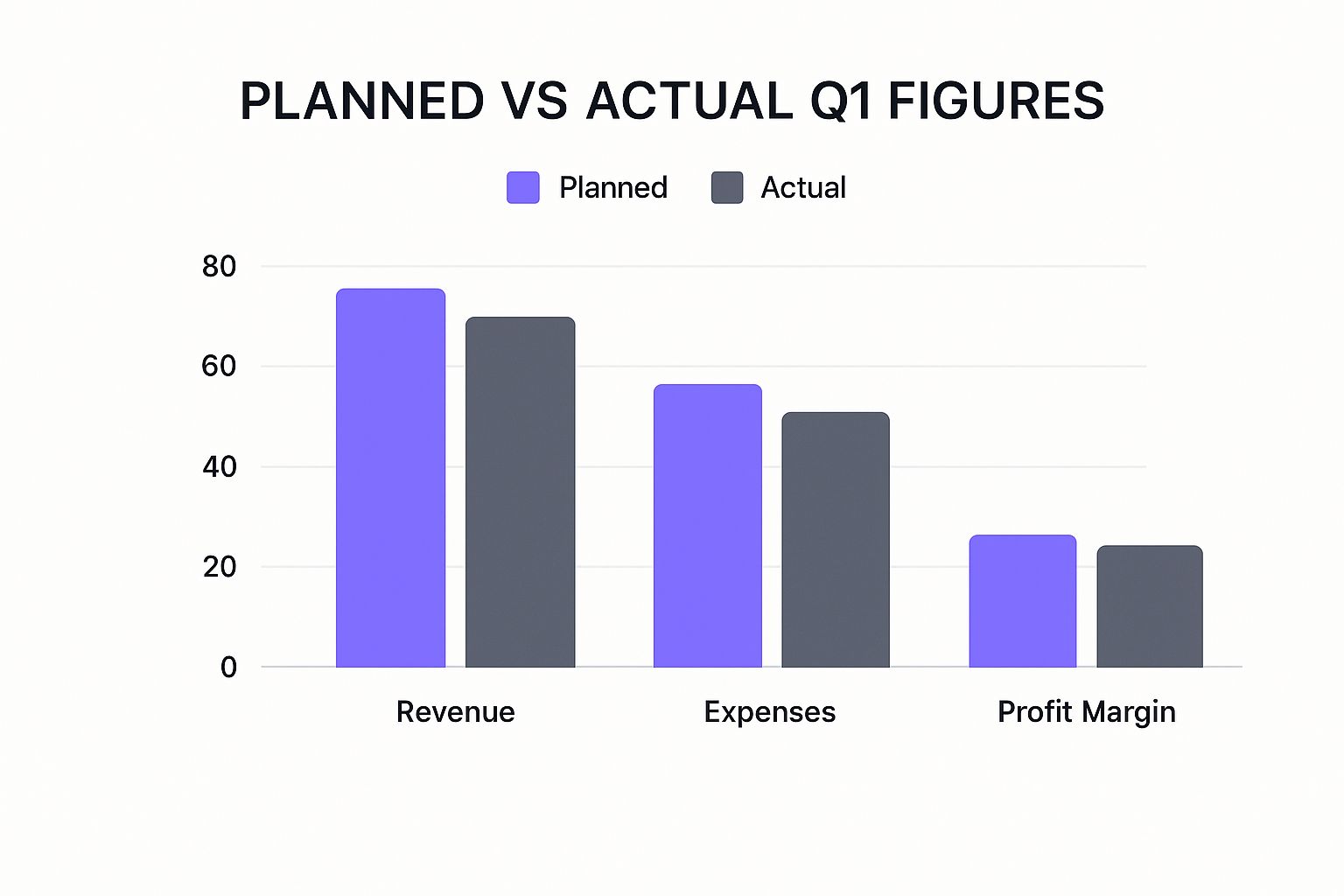
A good quarterly business review format is much more than just a structured agenda. It’s your chance to move past a simple data dump and build a strategic narrative. The best QBRs tell a story that recaps recent wins, dives into performance against key metrics, and, most importantly, helps you and your client build a roadmap together for the next 90 days.
Forget that last-minute panic of throwing slides together an hour before the meeting. A truly great Quarterly Business Review (QBR) starts weeks in advance. The most effective Customer Success Managers (CSMs) I know treat this prep time as an intelligence-gathering mission.
This foundational work is what separates a routine check-in from a high-value strategy session. It’s how you prove you're a real partner, not just another vendor.
The first move isn’t to start pulling data—it’s to understand what your client actually wants to talk about. Never assume you know. I always recommend reaching out to your main contact at least two or three weeks beforehand.
Don't just send over a rigid, pre-canned agenda. Instead, propose a few high-level themes you think are relevant based on their business goals, and then ask for their input. This little bit of collaboration works wonders. It guarantees the conversation will be relevant and makes them feel like a part of the process before the meeting even begins.
Before you even think about finalizing that agenda, you have to huddle up with your internal team. Seriously, this step is non-negotiable. There's nothing worse for your credibility than getting blindsided by a major support issue in the middle of your QBR.
Your internal sync should pull in people from every team that interacts with the account:
Presenting a unified front shows the client you’re an organized team that’s truly invested in their success. It prevents awkward surprises and keeps you in control of the conversation.
Okay, now you can start pulling the numbers. With the agenda co-created and your internal team on the same page, it's time to gather the data that will support your narrative. The core of any strategic QBR is solid data-driven decision making. It should inform every single part of your review and future planning.
Your goal here is not to overwhelm them with every chart you can generate. You need to curate the data points that tell a compelling story of progress and opportunity.
A QBR is not a data report; it's a value narrative supported by data. Select metrics that directly connect your product's usage to the client's stated business goals.
For example, if their main objective was to boost team efficiency, don't just show them how many users logged in. That’s a vanity metric. Instead, show them the data on time saved per task or a reduction in manual workflows.
Frame every number to answer the client’s silent question: "So what? What have you done for my business lately?" This is how you turn raw data into a powerful argument for your partnership.

Let's be honest: the first five minutes of your QBR can make or break the entire meeting. This is your moment to grab the attention of busy executives and prove this isn't just another vendor check-in. Don't waste it on generic pleasantries.
Your opening needs to be a sharp, high-level preview of the value you're bringing to the table. Think of it as the trailer for your movie—it should immediately hook them by connecting the meeting's purpose to their biggest business goals. A powerful opening confidently frames the value delivered last quarter and teases the strategic opportunities you're about to unveil.
To make sure your opening lands with maximum impact, you need to deliberately include a few key pieces. This isn't just an agenda; it's a strategic summary designed to get everyone aligned and engaged from the very first slide.
The table below breaks down the essential components to include in your opening to set a strong, value-focused tone for the rest of the conversation.
By structuring your introduction this way, you validate their time investment and position the QBR as a crucial strategic session, not just a routine update.
With the stage set, you can smoothly transition into recapping the quarter. The goal here is to tell a compelling story, not just rattle off a laundry list of completed tasks. Your narrative should connect every activity back to the goals you both agreed on in the last QBR.
A core part of any good quarterly business review format is looking back with honesty. This means covering the good, the bad, and the ugly: achievements, milestones, and yes, even the challenges. Being transparent here is how you build real trust. You can find more great insights on building these relationships on Mixmax.com. This honest review grounds the conversation and paves the way for a productive discussion about what’s next.
When you talk about successes, context is everything. "User adoption increased by 15%" is a start, but it doesn't really land. You need to connect that metric to a meaningful business result.
A much more powerful approach sounds like this: "Our shared goal was to boost operational efficiency. To that end, we saw user adoption climb by 15% last quarter. This directly led to a 10% reduction in manual data entry, saving your team an estimated 40 hours per week." Now that's a win.
A win without context is just a statistic. A win linked to a business goal is a demonstration of tangible value and a powerful testament to the return on their investment.
This simple shift in framing changes your role from a vendor to a strategic partner who’s genuinely invested in their bottom line. It proves you’re focused on their success, not just your product's features.
To make your wins stick, try this simple three-part structure:
No quarter is perfect, and every partnership hits a few bumps. Many CSMs get nervous about this part of the QBR, but it's actually a golden opportunity to build credibility. Trust erodes fastest when you try to hide problems or gloss over poor results.
The secret is to always approach challenges with a solution in mind. Never, ever bring up a problem without a well-thought-out plan to fix it. This demonstrates accountability and proactive leadership.
For instance, if a key project milestone was missed, don't just state the failure. Come prepared with a quick analysis of why it happened—was it a resource issue, a technical snag, or a shift in their priorities? Then, immediately pivot to your proposed solution, complete with a new timeline and clear action items. This changes the narrative from "We failed" to "We hit a roadblock, and here’s our plan to get back on track." It shows you’re committed to their success, even when the path isn't smooth.
This is where the rubber meets the road. After setting the stage with a strong agenda and recap, it's time to prove your value with hard numbers. This is the moment you shift the conversation from "here’s what we did" to "here’s the incredible impact it had," connecting your team's efforts directly to the client's bottom line.
Forget just listing activities. Your real job here is to weave performance data into a compelling story of progress and return on investment. This all comes down to choosing the right Key Performance Indicators (KPIs) – the ones that speak directly to what your client cares about most.
Don't fall into the classic trap of data dumping. I’ve seen too many QBRs derail because the CSM overwhelmed the client with every single metric their platform could track. Frankly, executives tune out when they see a wall of numbers. Your job is to be a curator, not a librarian.
The secret is to tailor your data presentation to their specific business and the goals you agreed upon in your last meeting.
For example, if you're working with a SaaS client whose main focus is user engagement, you'd want to highlight metrics like:
On the other hand, for an e-commerce client obsessed with growth, your story would revolve around an entirely different set of KPIs:
To build these reports without spending your entire week in spreadsheets, it’s worth looking into methods for automating business document creation, which can save a ton of time and reduce errors.
Choosing the right metrics can feel tricky, but it becomes much clearer when you start with the client's core objective. The table below is a quick guide I use to align common business goals with the most impactful KPIs.
Using a framework like this ensures you're not just presenting data, but telling a story that resonates with the executive team's top priorities.
Let’s be honest, raw numbers on a slide are snooze-inducing. The most effective way to make your data pop is to visualize it. Simple, clean charts and graphs make trends, wins, and even challenges immediately obvious.
A visual that shows planned vs. actual performance, like the one below, provides instant insight into how the quarter shook out.

This kind of chart does all the heavy lifting for you. It immediately highlights that while revenue and profit margin crushed their goals, expenses were a bit higher than planned. This gives you a perfectly balanced view and a natural starting point for a strategic discussion.
Data presented in a vacuum loses almost all of its power. A 10% jump in user engagement sounds nice, but what does it really mean? Is that good? How does it stack up against last quarter? Context is what transforms a simple number into a powerful insight.
A metric without a benchmark is just a number. A metric with a benchmark is a clear indicator of momentum and competitive positioning.
Always, always include benchmarks to give your data meaning. I recommend focusing on these three:
When you nail this data-backed storytelling, you solidify your role as an indispensable partner. The entire feel of the QBR shifts from a vendor update to a strategic planning session between equals, all driving toward real, measurable business outcomes.

The best QBRs I've ever been a part of weren't just a look back; they were a launchpad for what's next. Once you've laid out the performance data and proven your value, it's time to shift gears. This is where you pivot the conversation from review to strategy, moving from being just another vendor to a true, forward-thinking partner.
Your real goal here is to get the client to lean in and start planning with you. Let's be honest, many executives see QBRs as a box-ticking exercise. In fact, one study found that 72% feel they're too tactical and a waste of time. You sidestep that trap by making this final section a collaborative planning session. It's this move that solidifies your position as an advisor who's genuinely invested in their future.
Here's the biggest mistake I see CSMs make: they show up with a fully-baked plan for the next quarter. Don't do it. Your client shouldn't be a passive audience for your grand vision. This part of the meeting needs to feel more like a workshop—a brainstorming session where their input isn't just nice to have, it's essential.
Kick things off with a simple, open-ended question. Something like, "Based on everything we just looked at and your own priorities for the business, what does a huge win look like for your team in the next 90 days?" That question immediately hands them the reins.
Your job is to steer the conversation, connecting their aspirations back to the data and insights you've already presented.
When you take this approach, the resulting roadmap gets instant buy-in because they were part of building it.
Once you have a shared vision for next quarter's goals, now you can introduce new features, services, or strategies. The trick is to position them not as a sales pitch, but as the solution to the specific challenges they just helped you define.
For example, if the client is worried about scaling their support without growing the team, that's your cue. You could say, "You mentioned needing to handle more customer inquiries without adding headcount. Our new AI-powered chatbot feature, which is rolling out next month, is built for exactly that. It could potentially deflect up to 30% of routine questions."
A new feature presented out of context is just noise. A new feature presented as a direct solution to an agreed-upon goal is a strategic opportunity.
This makes your suggestions feel relevant and timely. It frames new offerings as tools for their success, not just items on your company’s to-do list. For a really thorough breakdown of how to structure this future-planning part of your review, check out this ultimate guide to product roadmap reviews.
The final piece of the puzzle is turning this great conversation into a concrete, actionable plan. A roadmap without clear details is just a list of wishes. You should end the meeting by outlining exactly what was agreed upon with total clarity.
For every single initiative, your roadmap needs to nail down three key things:
By locking in these components, you walk out of that meeting with a shared blueprint for the quarter ahead. This is how the quarterly business review format goes from a simple report to the very foundation of your strategic partnership, ensuring the momentum you built translates into tangible results.

Even the most brilliant QBR deck is only half the battle. Its real impact comes down to how you deliver it and, just as importantly, what happens after everyone leaves the room. I’ve seen perfectly crafted presentations fall completely flat because the CSM just read their slides, turning a potential strategy session into a one-sided monologue.
This is your moment to be more than a vendor; it's your chance to be a true partner. It’s all about managing the room, presenting with genuine confidence, and gracefully handling the tough questions. When you get this right, the QBR stops being a review and starts feeling like a dynamic, collaborative workshop.
The biggest rookie mistake? Reading your slides word-for-word. Your goal isn't to deliver a lecture; it's to spark a real conversation.
I’ve learned that the best way to do this is to deliberately build pauses into your delivery. After you share a key piece of data or highlight a major win, just stop. Ask an open-ended question. Something simple like, "Does this number track with what your team is seeing day-to-day?" can completely change the dynamic. It pulls people in, making them active participants instead of a passive audience.
Another technique I love, though it might feel a bit scary at first, is to openly invite challenges. Saying something like, "This is our take on why engagement dipped in Q2, but I'd love to hear if you have a different theory" is incredibly powerful. It shows you don't pretend to have all the answers and that you respect their expertise. That builds serious trust.
A QBR shouldn't feel like a presentation. It should feel like the most productive conversation the client has all quarter. Change your mindset from "presenting to" them to "collaborating with" them.
This conversational approach is your best bet for keeping executives tuned in. One study found that a staggering 72% of senior execs feel QBRs are often too tactical and a waste of their time. Fostering a real discussion is how you prove them wrong.
All the positive energy and momentum you build during the QBR can vanish in 24 hours without a rock-solid follow-up plan. The end of the meeting is actually the beginning of your next critical task. A sloppy or delayed follow-up pretty much tells the client that the conversation wasn't that important after all.
Your follow-up needs to be prompt, professional, and full of purpose. It’s your final chance to cement the value you delivered and pave the way for a productive quarter.
I always build my follow-up emails around three core elements:
Here’s a simple table format I use to make sure those action items are crystal clear and create accountability.
This level of detail leaves no room for confusion. It turns the big ideas from your QBR into a concrete project plan that everyone has bought into. This meticulous follow-through is what makes the QBR truly valuable long after the meeting ends, solidifying your role as a partner they can’t imagine working without.
Even the most seasoned Customer Success Manager has questions. After running hundreds of these meetings, I've found that the same handful of tricky situations pop up time and time again. Let’s get you the real-world answers you need to walk into your next QBR with total confidence.
Here's how I've learned to handle the most common challenges.
Aim for 60 to 90 minutes. That's the sweet spot. It gives you enough breathing room to recap the last quarter, dig into the meaningful insights, and map out the next steps together. Any longer, and you risk losing your audience to meeting fatigue.
Frankly, I've found that a tight 60-minute agenda is often a gift. It forces you to be ruthless in your preparation, cutting everything that isn't absolutely critical. Your client executives are busy people; they will thank you for getting straight to the point.
Of course, there are exceptions. For your most complex or strategic accounts, a two-hour deep dive might be necessary. If you need more time, make sure you get their buy-in well in advance. Frame it as a dedicated strategy session, not just a longer meeting—it shows you respect their calendar.
This one’s simple: tactical vs. strategic. Confusing the two is a common mistake, but the distinction is crucial for setting the right expectations.
A check-in tells you the engine is running. A QBR confirms the car is heading in the right direction and delivering real value.
You walk in and own it. The only way to navigate a tough quarter is with complete, head-on accountability. Trying to spin the numbers or downplay bad news is the fastest way to destroy trust. Your client will respect your transparency far more than a sugar-coated story.
First, present the data clearly. Don't make excuses. Then, immediately pivot to a sharp analysis of why things went south. Was there a shift in their market? Did we uncover a product gap? Did a specific strategy just not deliver?
The most critical part isn't explaining the problem; it's presenting the solution. A bad quarter is an opportunity to showcase your team's problem-solving skills and unwavering commitment.
Follow your analysis with a rock-solid recovery plan. This can't be vague. It needs specific actions, clear owners on both your team and theirs, and realistic timelines. This approach turns a potentially painful meeting into a powerful display of your partnership.
Getting the right people to show up is half the battle. Your goal is to have the perfect mix of practitioners and decision-makers.
Your day-to-day champion is a must-have; they live and breathe your product and can speak to the on-the-ground reality. But the real game-changer? Getting their executive sponsor or budget holder in the room. These are the people who ultimately care about business impact and ROI.
When the executive sponsor is present, you have a direct line to showcase your value to the very person who signs off on renewals and expansions. Work with your champion to get them there. Position the QBR as a critical business review, not just another vendor update, and they'll be far more likely to accept the invitation.
Are you tired of manually compiling data and wrestling with slides for every QBR? Statisfy uses AI to automatically transform your customer data into the compelling, value-driven narratives that executives want to see. Our platform helps you prepare for strategic conversations in a fraction of the time, so you can focus on what you do best—building strong customer relationships. See how you can deliver your best QBR yet.